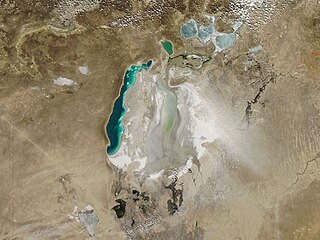Aral Sea
Most of the area around the Aral Sea was inhabited by desert nomads who left few written records. However, the Oxus delta to the south has a long history under the name of Khwarezm. It was once the westernmost border of Tang dynasty China.
The Aral Sea is considered an example of ecosystem collapse. The ecosystems of the Aral Sea and the river deltas feeding into it have been nearly destroyed, not least because of the much higher salinity. The receding sea has left huge plains covered with salt and toxic chemicals resulting from weapons testing, industrial projects, and pesticides and fertilizer runoff. Due to the shrinking water source and subsequent worsening water and soil quality, pesticides were increasingly used starting in the 1960s to increase cotton yields, which further polluted the water with toxins such as DDTs. Furthermore, “PCB-compounds and heavy metals” from industrial pollution contaminated both water and soil. Due to the minimal amount of water left in the Aral sea, concentrations of these pollutants have increased drastically in both the water and soil. These substances form wind-borne toxic dust that spreads throughout the region. People living near the Aral Sea come in contact with pollutants through drinking water and inhalation of contaminated dust. Furthermore, due to the presence in drinking water, the toxins have entered the food chain. As a result, the land around the Aral Sea is heavily polluted, and the people living in the area are suffering from a lack of fresh water and health problems, including high rates of certain forms of cancer and lung diseases. Respiratory illnesses, including tuberculosis (most of which is drug resistant) and cancer, digestive disorders, anaemia, and infectious diseases are common ailments in the region. Liver, kidney, and eye problems can also be attributed to the toxic dust storms. All of this has resulted in an unusually high fatality rate among vulnerable parts of the population: the child mortality rate is 75 in every 1,000 newborns, and maternity death is 12 in every 1,000 women.
- Aral Sea dust storm, March 2010
- Abandoned ship near Aral, Kazakhstan
- A former harbour in the city of Aral
- Local Kazakh fisherman harvesting the day's catch
Your notes (private)
What's on your mind? (you can type here notes just for you and they will show on your dashboard)
Information for getting there
When someday comes you'll need to get in.
Information for getting around
When someday comes you'll need to be able to get around.
Your tips and questions
Let us know your best tips about Aral Sea.




